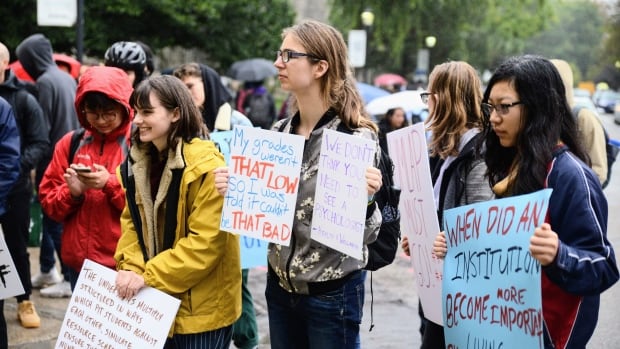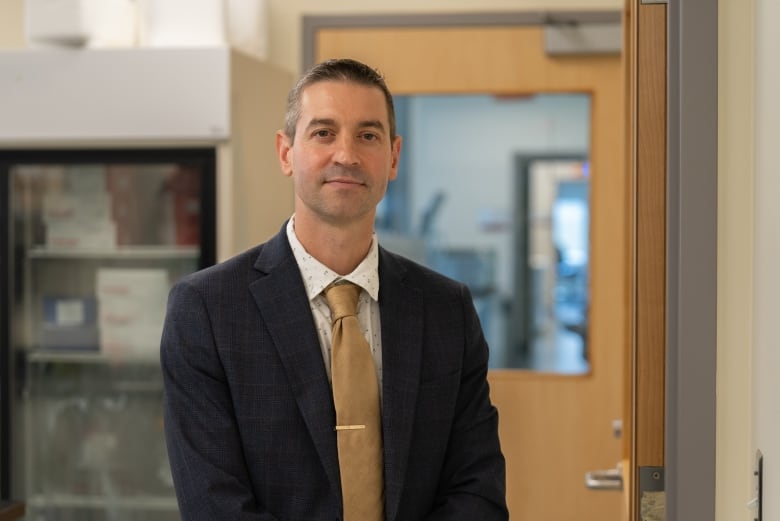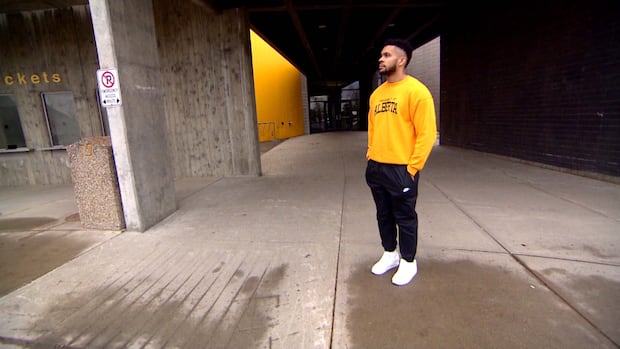
WARNING: This story contains discussion of suicide.
Marien de Freitas has seen one too many friends die by suicide.
De Freitas started at the University of Waterloo in the fall of 2020, right at the peak of the pandemic. Classes were all online, and the isolation amplified anxiety and other mental health issues for her and other students.
By the end of that school year, one of her friends had taken their own life, and she had witnessed another student’s suicide attempt. But even as students grieved and sought an open discussion, she says there was little acknowledgement from the university.
“After it happened, nothing really changed,” de Freitas told CBC News. “Everyone’s expected to go back to normal life, and the school can’t even acknowledge that some students didn’t even survive last exam season.”

Despite ongoing reports of poor mental health and suicides among post-secondary students, an exclusive CBC News investigation has found that more than 70 per cent of Canadian universities do not track suicides or attempted suicides among students. Without that data, experts say it’s difficult to even understand how big the issue is.
CBC News asked 52 of the country’s largest universities whether or not they track both suicide attempts and deaths by suicides and requested the data for the last five years.
Fifteen schools said they internally track student suicides. Of those schools, only six provided CBC with actual figures.
Of the remaining 37 universities, 24 said they did not track. A further five replied to the request but did not respond to the question about tracking, and another five schools said they track medical events but not necessarily suicide.
“Knowledge is power,” said Zachary Kaminsky, associate professor at University of Ottawa’s faculty of medicine.
“If you’re not paying attention to what’s going on in terms of the mental health of your students, then you’re not in a position to be able to try to improve that mental health.”

Kaminsky, who is also chair of suicide prevention research at The Royal, a mental health hospital in Ottawa, says researchers like him rely on data to accurately track the issue.
“If we don’t track, then we can’t act,” he said, noting that having accurate numbers provides schools with a better understanding of the effectiveness of their mental health services, and allows researchers to create “novel innovative tools” for suicide prevention.
Young adults vulnerable
Several students, including de Freitas, told CBC News that mental health and suicide are a rising concern on post-secondary campuses since the pandemic.
For three consecutive years, three-quarters of students were negatively impacted by the pandemic, according to a September 2022 report published by the Canadian Alliance of Student Associations and the Mental Health Commission of Canada. Younger students and those from marginalized backgrounds were also at greater risk.
During his first year at the University of Alberta in 2019, Isaiah Neil says his mental health plummeted when he had difficulties with his grades and suffered a concussion.
“After about a month of being depressed, I had suicidal ideation and had to go see a therapist, worked some things out,” said Neil, who is now in his fifth year and notes that he’s struggled with suicidal thoughts and depression on and off ever since that first year.
None of the six schools in Alberta track student suicides.
Neil, who is now a senior speaker with the youth mental health organization Jack.org, says public numbers on student suicides would help destigmatize the issue and help people like him realize they aren’t alone.
“There’s a lot of people struggling with suicide and we don’t even know it,” he said.
University of Alberta student Isaiah Neil has struggled with depression and suicidal ideation since he started his studies in 2019. He says seeking help from his school was very frustrating as services are often overbooked.
Corey McAuliffe, an adjunct faculty member at the University of British Columbia School of Nursing, says academic institutions can be “toxic spaces” where students face immense pressure to prioritize grades and accomplishment over their mental wellbeing.
“There’s this constant stress of doing more and accomplishing more and that it’s never enough,” said McAuliffe, a research associate at the Canadian Mental Health Association’s B.C. division.
Suicide is the second-leading cause of death (after accidents) among young people ages 15 to 24 since at least 2000, according to Statistics Canada. The data also shows that between 2018 and 2022, more than 2,500 people in that age group have died by suicide.
McAuliffe, who has worked with universities to develop strategies for student mental health, says the institutions can at times be defensive when discussing the issue.
“Some of that comes from the fear that they will be seen as responsible,” she said.
“They don’t have the resources, often, to be able to address them, especially when they are not getting funding to be able to do so.”
Corey McAuliffe, a research associate at the Canadian Mental Health Association’s B.C. division, says it’s important for universities to track both suicides as well as suicidal ideation so they know what type of help their students need and can actually address the problem.
McAuliffe says it’s the government’s responsibility to help fund mental health services for youth at post-secondary institutions, where there is a unique opportunity to support students in their time of need.
“This is a time period where they are most likely to have their first diagnosis … of a mental health condition,” she said.
But Kaminsky emphasizes that in order to help, universities first need to understand the problem of suicide, because that “lets us not put our heads in the sand, but to understand where to attack the problem.”
Mental health a priority, universities say
In emailed responses to CBC News, the majority of universities said the mental health of their students is a priority, and outlined the mental health resources available on campus, with many emphasizing increased levels of counselling and other services in the last few years.
CBC News also requested interviews with senior administration of 12 schools that told CBC News they do not track suicides. None of the schools agreed to interviews, but several responded with statements reiterating their commitment to student mental health.
Of the twelve schools, five — the University of Ottawa, Western University, Wilfrid Laurier University, the University of Alberta and the Memorial University of Newfoundland — told CBC News they tracked student suicides in 2019, but no longer do so.
In a statement, the University of Alberta said its 2019 numbers reflected only the cases where the university was notified by families, and says that it currently keeps track of students dealing with suicidal ideation when they’re made aware.
After publication, the University of Alberta further clarified that it does track information on student deaths when notified, including suicides, but does not disclose the data to protect students’ privacy.
More than 70 per cent of Canadian universities don’t track suicides or attempted suicides, a CBC News investigation has found. Advocates say that makes it difficult to grasp the severity of the problem and what additional resources are needed to help.
Universities that don’t track suicides told CBC News that they face a range of challenges when it comes to collecting reliable data. Some said their student bodies were too small. Others said the majority of their students were commuters, making it difficult to know if a student died by suicide if the death occurred off campus.
Eighteen of the 52 schools stated they couldn’t track or share data on student suicides due to privacy concerns.
The University of Manitoba, for example, says it tracks “campus medical events broadly” but does not further categorize them to “ensure privacy protection.”
“We would not always be aware if a student has attempted suicide and we do not ask families or require them to disclose the cause of death for a loved one,” it wrote in a statement.
Among the largest universities that do not track, the University of British Columbia says it relies on “student feedback, usage statistics of our counselling and primary care services, and professional assessments” to track the effectiveness of its services.
Most provincial coroners don’t track
Andrea Howell knows firsthand the difficulties of getting a university to meaningfully acknowledge a student suicide.
Howell’s son, Chase, died by suicide in 2017 while studying at the University of Waterloo. She says despite her family being open to grieving with the school community, the university was reluctant to talk about it.
“I would have been very happy to be vocal — and I was — about what had happened,” she said, noting that university administration opted to send out a general statement citing privacy instead. “It didn’t have to be me against the university.”
Andrea Howell lost her son, Chase, to suicide in 2017 while he was attending the University of Waterloo. She tells CBC News what is was like finding out about her son’s death and how she wishes the subject of suicide was more openly discussed on campus.
After seeing the lack of awareness around student suicides, she urged the Ontario Office of the Chief Coroner to add a “student” category for suicides to inform public health decisions in the province. That change was implemented four years later, but only became mandatory in 2023.
Coroners in Quebec and B.C. provided CBC News with preliminary figures for post-secondary student suicides but said they don’t track systematically. The B.C. coroner noted that it can’t always tell if a person who dies by suicide is a student.
The coroner’s offices of the other seven provinces say they do not track suicides by students.
Howell is happy to hear that some provinces now track this information and hopes it can help spur future public health decisions.
“Once there’s some numbers, perhaps that will lay down some groundwork for some further study or maybe an inquest in the future.”
Now just a few months from graduating with an undergraduate degree in psychology, de Freitas appreciates that Waterloo is one of the universities that tracks suicides, but says it must do more to destigmatize mental health struggles, especially in a competitive academic environment.
She says it’s the university’s responsibility to make students feel safe enough to be vulnerable while also pursuing their education. “To let them know, ‘Hey, your life is worth so much more than this degree that we have to offer you.’ “
If you or someone you know is struggling, here’s where to get help:





